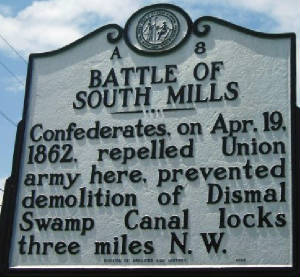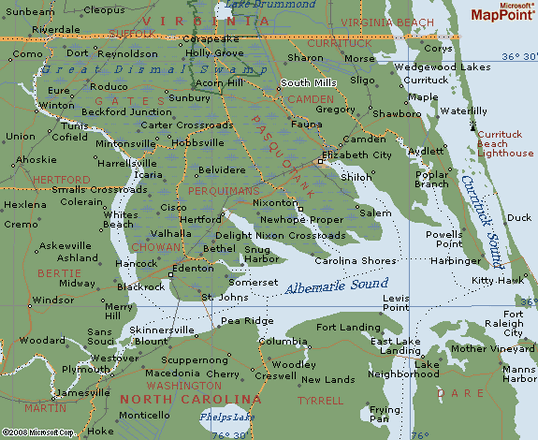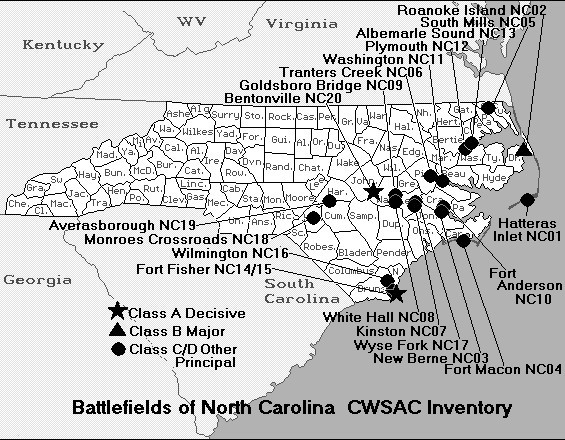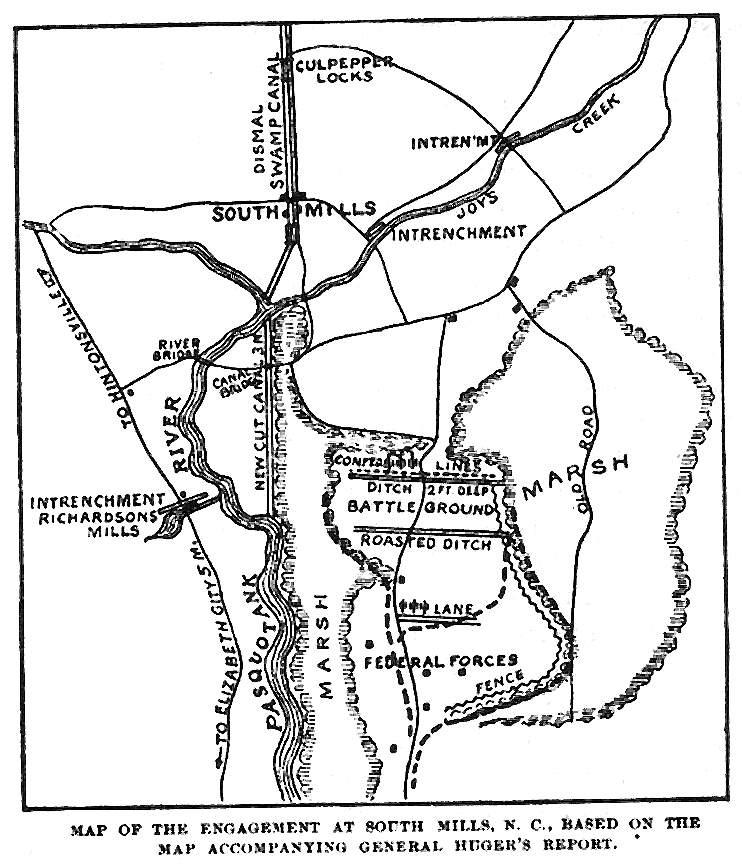|
Battle of South Mills History
South Mills and the American Civil War
Battle of South Mills
Other Names: Camden
Location: Camden County
Campaign: Burnside's North Carolina Expedition (February-June 1862)
Date(s): April 19,
1862
Principal Commanders: Brig. Gen. Jesse Lee Reno [US]; Col. Ambrose
Wright [CS]
Forces Engaged: 21st Massachusetts and 51st Pennsylvania [US];
3rd Georgia [CS]
Estimated Casualties: 150 total (US
120; CS 30)
Result(s): Inconclusive (Federals withdrew.)
| The Battle of South Mills, North Carolina |

|
| Battle of South Mills |
Introduction: Camden
County, North Carolina, was settled when English settlers drifted down the Pasquotank River from the Virginia colony. Camden
County had an important role to play in the Revolutionary War, contributing 416 officers and soldiers, the most of any county
in northeast North Carolina. The county split from Pasquotank County in 1777 to become an independent county. George Washington
commissioned the construction of the Dismal Swamp Canal, which took twelve years to build; the construction period lasted
from 1793 to 1805. The dirt that was excavated for the canal was used to build the bed of a toll road. (The location of the
toll road is now the location of U.S. Highway 17.) The construction of the canal brought many economic benefits to the village
of South Mills, such as the construction of mills near the southern locks of the canal.
During the Civil War, the Battle of South Mills would be fought near the village on April 19, 1862.
Background: Union General Ambrose Burnside’s
expedition into eastern North Carolina in 1862 scored a series of successes with the capture of Roanoke Island in February,
New Bern, and Washington in March, and Fort Macon in April. (See also North Carolina Coast and the American Civil War.)
Among the few Confederate victories in that season was the defeat of a force
sent to destroy the Dismal Swamp Canal locks at South Mills. Burnside ordered 3,000 men under General Jesse Reno to blow up
the locks in order to preclude the chance that Confederate ironclad gunboats might be floated down the canal from Norfolk. The
troops landed just south of Elizabeth City on the evening of April 18. Carrying with them two wagons of explosives, the Federals made a strategic error by taking
a wrong road and adding ten miles to their overland route north. (They executed the mulatto guide who had misled them.) Weary
and robbed of any chance of surprise, the Union troops meet 900 Confederates, commanded by Colonel Ambrose Wright, a few miles
below South Mills.
| North Carolina and the Civil War |

|
| Location of South Mills |
| North Carolina and the Civil War |

|
| Battle of South Mills, North Carolina |
Battle: Learning that the Confederates were building ironclads
at Norfolk, Burnside planned an expedition to destroy the Dismal Swamp Canal locks to prevent transfer of the ships to Albemarle Sound. He entrusted the operation to Brig. Gen. Jesse Lee Reno’s command, which embarked on transports from Roanoke Island on April 18. By midnight, the convoy reached Elizabeth City and began disembarking
troops.
On the morning of April 19, Reno marched north on the road to South
Mills. At the crossroads a few miles below South Mills, elements of Col. Ambrose Wright’s command delayed the Federals
until dark. Reno abandoned the expedition and withdrew during the night to the transports at Elizabeth City. The transports
carried Reno’s troops to New Berne (present-day New Bern) where they arrived on April 22. (See also Civil War Battle of South Mills, by D. H. Hill, Jr.)
| Battle of South Mills, North Carolina |

|
| (Union and Confederate Battlefield Positions) |
(Sources listed at bottom of page.)
Recommended Reading:
The Civil War on the Outer Banks: A History of the Late Rebellion
Along the Coast of North Carolina from Carteret to Currituck With Comments on Prewar Conditions and an Account of
(251 pages). Description: The ports at Beaufort, Wilmington, New Bern and Ocracoke, part of the Outer Banks (a chain of barrier
islands that sweeps down the North Carolina coast from the Virginia Capes to Oregon Inlet), were strategically vital
for the import of war materiel and the export of cash producing crops. Continued below...
From official records, contemporary newspaper accounts, personal journals of the soldiers, and many unpublished
manuscripts and memoirs, this is a full accounting of the Civil War along the North Carolina coast.
Advance to:
Recommended Reading: Ironclads and Columbiads: The Coast
(The Civil War in North Carolina) (456 pages). Description: Ironclads and Columbiads covers some of the most
important battles and campaigns in the state. In January 1862, Union forces began in earnest to occupy crucial points on the
North Carolina coast. Within six months, Union army and
naval forces effectively controlled coastal North Carolina from the Virginia
line south to present-day Morehead City.
Continued below...
Union setbacks in Virginia, however, led to the withdrawal of many federal soldiers from North Carolina,
leaving only enough Union troops to hold a few coastal strongholds—the vital ports and railroad junctions. The South
during the Civil War, moreover, hotly contested the North’s ability to maintain its grip on these key coastal strongholds.
Recommended Reading: The Civil War in the Carolinas
(Hardcover). Description: Dan Morrill relates the experience
of two quite different states bound together in the defense of the Confederacy, using letters, diaries, memoirs, and reports.
He shows how the innovative operations of the Union army and navy along the coast and
in the bays and rivers of the Carolinas affected the general course of the war as well as
the daily lives of all Carolinians. He demonstrates the "total war" for North
Carolina's vital coastal railroads and ports. In the latter part of the war, he describes
how Sherman's operation cut out the heart of the last stronghold
of the South. Continued below...
The author
offers fascinating sketches of major and minor personalities, including the new president and state governors, Generals Lee,
Beauregard, Pickett, Sherman, D.H. Hill, and Joseph E. Johnston. Rebels and abolitionists, pacifists and unionists, slaves
and freed men and women, all influential, all placed in their context with clear-eyed precision. If he were wielding a needle
instead of a pen, his tapestry would offer us a complete picture of a people at war. Midwest Book Review: The Civil War in the Carolinas by civil war expert and historian
Dan Morrill (History Department, University of North Carolina at Charlotte, and Director of the Charlotte-Mecklenburg Historical
Society) is a dramatically presented and extensively researched survey and analysis of the impact the American Civil War had
upon the states of North Carolina and South Carolina, and the people who called these states their home. A meticulous, scholarly,
and thoroughly engaging examination of the details of history and the sweeping change that the war wrought for everyone, The
Civil War In The Carolinas is a welcome and informative addition to American Civil War Studies reference collections.
Recommended Reading: Storm
over Carolina: The Confederate Navy's Struggle for Eastern North Carolina. Description: The struggle for control of the eastern
waters of North Carolina during the War Between the States
was a bitter, painful, and sometimes humiliating one for the Confederate navy. No better example exists of the classic adage,
"Too little, too late." Burdened by the lack of adequate warships, construction facilities, and even ammunition, the
South's naval arm fought bravely and even recklessly to stem the tide of the Federal invasion of North
Carolina from the raging Atlantic. Storm
Over Carolina is the account of the Southern navy's struggle in North
Carolina waters and it is a saga of crushing defeats interspersed with moments of brilliant and even
spectacular victories. It is also the story of dogged Southern determination and incredible perseverance in the face
of overwhelming odds. Continued below...
For most of
the Civil War, the navigable portions of the Roanoke, Tar, Neuse, Chowan, and Pasquotank rivers were
occupied by Federal forces. The Albemarle and Pamlico sounds, as well as most of the coastal towns and counties, were also
under Union control. With the building of the river ironclads, the Confederate navy at last could strike a telling blow against
the invaders, but they were slowly overtaken by events elsewhere. With the war grinding to a close, the last Confederate vessel
in North Carolina waters was destroyed. William T. Sherman
was approaching from the south, Wilmington was lost, and the
Confederacy reeled as if from a mortal blow. For the Confederate navy, and even more so for the besieged citizens of eastern
North Carolina, these were stormy days indeed. Storm Over Carolina describes their story, their struggle, their history.
Recommended Reading: The Civil War
in Coastal North Carolina (175 pages) (North Carolina Division of Archives and History). Description: From the drama of blockade-running to graphic descriptions of battles
on the state's islands and sounds, this book portrays the explosive events that took place in North Carolina's coastal region during the Civil War. Topics discussed include the strategic
importance of coastal North Carolina, Federal occupation
of coastal areas, blockade-running, and the impact of war on civilians along the Tar Heel coast.
Sources: John G. Barrett, The Civil War in North Carolina (1963); William R. Trotter,
Ironclads and Columbiads: The Civil War in North Carolina:
The Coast (1989); Official Records of the War of the Rebellion; National Park Service.
|

